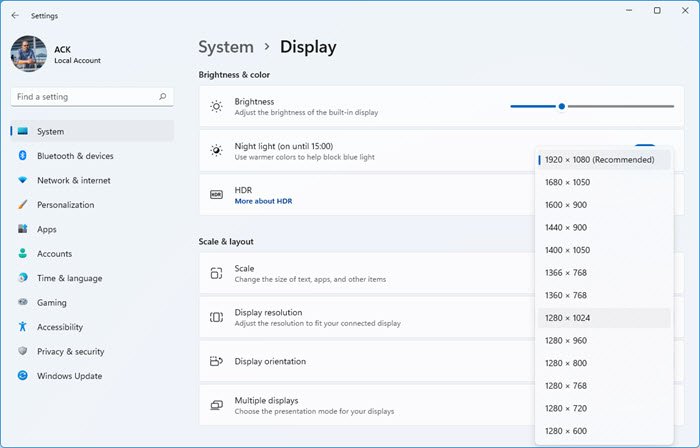Just before you start, let’s try some basic tips. Open Settings where you get to change the screen resolution. Go to Settings > System > Display. You should see a dropbox under the label Resolution. See if you can change it to a resolution which either you want to is better than this. Sometimes, because of some issue, the display drivers automatically change the screen resolution. If this doesn’t solve your problem, let’s try other methods.
Cannot change Screen Resolution in Windows 11/10
The primary reason for this issue is driver misconfiguration. Sometimes Drivers aren’t compatible, and they choose a lower resolution to stay safe. So let’s first update the Graphics driver or maybe rollback to the previous version. Note: Try this fix if only your apps are blurry.
1] Update or Roll Back Graphics Driver
Open Device Manager ( WIN + X + M)Expand Display Adapters, and select the GPU listed there.Note down the OEM, and Model no, and download the latest driver from their website.Run the driver program which you just downloaded, and install it.If it’s an INF file or some other format, you can right-click on the CPU, and update the driver.It will ask you to locate the INF file, and then install it.
In case your driver is already updated to the latest version, you can try rolling back to the old driver. It is only possible if you have a backup for your driver before the update or you can find one on the OEM website.
2] Turn on GPU Scaling
If you own an AMD graphics card or NVIDIA, you may want to check GPU scaling option. It allows scaling the image, so it fits the screen both vertically and horizontally, i.e., no black borders. AMD:
Open your AMD Radeon settingsClick on ‘Display’Find GPU Scaling there and enable it
NVIDIA: Open NVIDIA Control Panel. Here you have two options: a) Change Resolution or Create New Resolution: Here you can create a custom resolution for your display, but keep the refresh rate same.
You can test before finalizing. This is useful when you know a particular resolution was there, but the monitor resolution not listed now. b) Adjust Desktop Size: You can choose between Full Screen, Aspect Ratio, or no scaling. Scaling can be on GPU level or just monitor. Here is a bit of warning though. While it might not show any visible signs during regular work including video playback, you might see noticeable lag when playing a video game.
If your problem is only limited to a particular app, you may want to give it access to GPU. Go to Settings > System > Display > Graphics Settings. These are the only possible solutions we have noticed when Windows 11/10 won’t let you change the resolution of your display. Sometimes, the resolution is stuck at a lower resolution, and there is no way to fix it. If these don’t solve the problem for you, I would suggest one last thing before reinstalling Windows. Create a new account, and see if it works for you. Sometimes, accounts get corrupted, and profiles cant be fixed. Let us know if any of these tips helped you.
